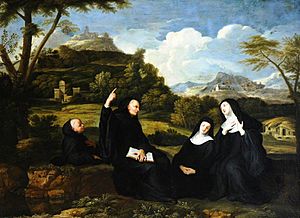Scholastica facts for kids
Quick facts for kids SaintScholastica |
|
|---|---|

Saint Scholastica, Saint Benedict and companions
|
|
| Virgin | |
| Born | c. 480 Nursia, Umbria (now Italy) |
| Died | 10 February 543 near Monte Cassino (now Italy) |
| Venerated in | |
| Canonized | Pre-Congregation |
| Feast | 10 February |
| Attributes | in Benedictine religious habit, with crozier and crucifix; with dove flying from her mouth |
Saint Scholastica was a very special person who lived a long time ago, from about 480 AD to 543 AD. She is known as a saint in several Christian churches, including the Catholic Church. Many people believe she was the twin sister of Saint Benedict, another famous saint.
Her special day, called Saint Scholastica's Day, is celebrated every year on February 10th. She is also seen as the person who started the Benedictine nuns, a group of religious women.
Contents
Her Early Life
We learn about Scholastica from a book written by Gregory the Great in the late 500s. This book is called Dialogues. It says Scholastica was born around 480 AD in a place called Nursia in Italy. Her parents were wealthy.
Gregory tells us that Scholastica was Benedict's sister. Later stories say they were twins, meaning they were born at the same time. From a very young age, Scholastica was dedicated to God. She and Benedict grew up together until he left to study in Rome.
In those days, a young woman like Scholastica would usually stay at home until she got married. But some women chose a religious life. They might live together in a community.
Many people believe that Scholastica started a special place for nuns, about five miles from Monte Cassino. This was likely the first convent for Benedictine nuns. It's also possible she lived with other religious women near Mount Cassino. There is even an old church there named after her.
A Special Story About Scholastica
There's a famous story about Scholastica and her brother Benedict. Once a year, she would visit him near his monastery. They would spend the day praying and talking about important religious ideas.
One day, they were having supper and continued their deep conversation. Benedict said it was time for him to leave and go back to his monastery. Scholastica, perhaps feeling that her life was ending soon, asked him to stay. She wanted to keep talking with him through the night.
But Benedict said no. He didn't want to break the rules of his monastery, which said he had to return to his cell. So, Scholastica put her hands together and prayed. Right after she prayed, a huge storm suddenly started outside!
Benedict was surprised and asked, "What have you done?" Scholastica replied, "I asked you to stay, and you wouldn't listen. So, I asked my God, and He did listen! Now, try to leave if you can. Go back to your monastery!" Because of the storm, Benedict couldn't leave. So, they spent the whole night talking.
Three days later, Benedict was in his cell. He saw his sister's soul leaving the earth. It looked like a bright white dove flying up to heaven. Benedict had her body brought to his monastery. He buried her in the tomb he had prepared for himself.
Learning About Scholastica
Most of what we know about Scholastica comes from the Dialogues written by Gregory the Great. Old calendars and place names around Monte Cassino show that Gregory's story about her life is likely true. Gregory said he got his information from four people who lived at the same time as Benedict.
Honoring Saint Scholastica
Scholastica is known as the patron saint of Benedictine nuns. She is also a patron saint for education and for children who have seizures. People also pray to her for protection against storms and rain.
Her feast day is celebrated on February 10th. This day is very important in the Benedictine calendar.
In pictures and statues, Scholastica is usually shown wearing the special clothes of a Benedictine nun. She often holds the Rule of Saint Benedict book. Sometimes, she is shown with a crucifix or a dove flying upwards.
Scholastica was even featured on a special coin in Austria in 2002. On this coin, she is shown with Saint Benedict.
She is honored on the calendars of the Church of England and the Episcopal Church on February 10th.
See also
 In Spanish: Escolástica de Nursia para niños
In Spanish: Escolástica de Nursia para niños
- List of Catholic saints
- St Scholastica Day riot


